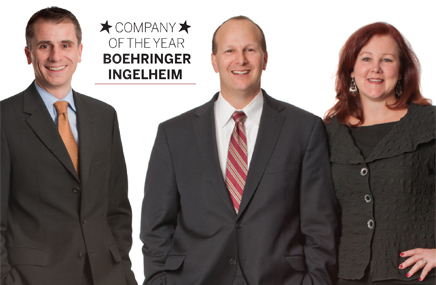COMPANY OF THE YEAR: BOEHRINGER INGELHEIM
From left: President/CEO Greg Behar; David Pass, VP, US pipeline marketing; and Kathleen Dowd, VP, respiratory marketing
Boehringer Ingelheim: 126 years old. Privately owned. German. Should be a fusty, conservative sort of company, content to play it safe and leave the innovation to its publicly traded peers, right? Falsch!
Boehringer, or BI, is more like the BMW of pharma, consistently showing up competitors with exciting products like Pradaxa (dabigatran) and some of the boldest, smartest advertising and promotion in the industry. BI hopes to launch six more products in the next two years. When most companies are slashing headcounts to pad share buybacks, BI is investing in a major US expansion, spending $350 million to build out its R&D infrastructure in its top market, representing 45% of global sales.

“The first thing that strikes you when you join BI is the long-term approach,” says Greg Behar, president and CEO. “Because it’s not driven by share price, the shareholders take a long-term view on strategy and the financial health of the company, and that really drives the culture.”
More than a fifth of revenues from sales go back into R&D, notes Behar, a native of Switzerland who joined Boehringer from Novartis three years ago. And BI, he says, maintains a cohesive culture across borders by nurturing its employees.
BI is a particularly polyglot company in an ever more global industry. Brits constitute a plurality of the firm’s 42,000 employees, and besides Germany, Holland and the US are well represented. Japan is BI’s second-biggest market after the US, followed by Germany.
The company invested upwards of $350 million in its US operations this year, building, buying or upgrading facilities in five states.
A year ago, the firm inked a joint venture with Eli Lilly to collaborate on diabetes drugs, including BI’s oral agents linagliptin (Tradjenta) and BI10773. In return, BI got a €300 million upfront payment and comarketing rights on Lilly’s two basal insulin analogues, along with an option to co-develop and commercialize Lilly’s anti-TGF-beta monoclonal antibody.
“We’re not just dipping our toes in the water,” says Behar. “We want to be an important player in diabetes and we want to be there for the long term.” What made Lilly an appealing partner was their status as “the number one diabetes company among endocrinologists in the US,” and the fact that BI “had already had several recent partnerships with them.”
The partnership has already borne fruit—Tradjenta won FDA approval for treatment of Type 2 diabetes in May. EU approval followed in August.
The company’s biggest recent approval, of Pradaxa for prevention of stroke and blood clots in patients with atrial fibrillation, came in October 2010. The drug—the first new drug in 50 years for that condition—marked a turning point not only for a company trying to get out ahead of a wave of patent expirations, but for an industry beset by safety scandals and weak pipelines. It said to the world that pharmaceutical innovation, producing life-saving treatments, was still possible.
Behar was in Barcelona at a major European cardiology society meeting when news of the 18,000-patient RELY trial, demonstrating Pradaxa’s superiority to warfarin, broke in a presentation. Four thousand cardiologists leapt to their feet and applauded.
“It was just a fantastic emotional moment,” says Behar.
The enthusiasm of doctors for the drug is shown in consumer ads, which feature white-coated physicians talking up Pradaxa for stroke prevention in patients with atrial fibrillation.
“We did extensive market research,” says David Pass, who heads cardiovascular and metabolic marketing along with US pipeline marketing at BI. “We saw a lot of patients were concerned about the symptoms, but few were really concerned about the stroke risk, which really suggested for us, from a patient educational perspective, that we needed to focus on that link between AFib and stroke.”

The company recently launched DTC for Spiriva, following a new indication for COPD exacerbations, featuring images of an elephant sitting on patients’ chests, meant to illustrate what sufferers say they feel like.
“We looked at the category, and there are a lot of similarities—smiling grandmas hugging the grandchild,” says VP respiratory marketing Kathleen Dowd. “We did a lot of testing to get to that true insight.”
BI partnered with NASCAR and the Country Music Association for its DRIVE4COPD awareness campaign, which makes deft use of celebrity ambassadors through social media channels like Twitter and Facebook.
The company’s comfort level with social media is a standout. When Facebook made pharmas activate comments, raising fears of exposure to adverse-events reporting requirements, BI beefed up monitoring while many shuttered their pages. HealthSeeker, a Facebook game on which BI collaborated with the Diabetes Hands Foundation and the Joslin Diabetes Center, was an industry first.
In addition to solid pipelines in cardiovascular, respiratory (asthma, COPD, lung cancer and idiopathic pulmonary fibrosis) and diabetes (SGLT2 inhibitors), BI is pursuing candidates in oncology (angiogenesis inhibitors, CDK kinase inhibitors and signal transduction pathways) and a promising oral hepatitis C drug to compete with Vertex’s Incivek and Merck’s Victrelis, with another HCV treatment in Phase II. In respiratory, where BI is rooted, the firm launched Respimat SoftMist Inhaler, a delivery device 10 years in the making.
“If you look at the statistics for COPD, it’s staggering and really sad,”says Dowd, whose mother has the disease. “It’s the fourth leading cause of death in the US. It kills more Americans than breast cancer and diabetes combined, and out of 24 million people that are symptomatic, only half are diagnosed. It’s outrageous. As leaders in this marketplace, we need to change this paradigm.”
From the January 01, 2012 Issue of MM+M - Medical Marketing and Media








